Who wrote the best, most famous, and beautiful poems in Hungary? If the works of fine art in the public space also show the recognition and appreciation of the nation, then in Budapest so far three poets have earned the title of the greatest poet: János Arany, Sándor Petőfi and Mihály Vörösmarty. The monumentality of the works and the choice of location at the level of symbols also elevated these three poetic heroes among our national greats.
The others received a smaller monument in terms of the size of the work, and the sites of their capture also have less symbolic value and a central role. Of course, the monuments bear witness and tell more about the age of the time of their creation and the ideas of that time, and in this context, it is perhaps even more interesting to review what kind of memorial place our great Hungarian poets got on the streets and squares of the capital.
The first public memorial statue in Budapest depicting our national greats was awarded to József Katona, who, as the author of Bánk Ban, is a prominent figure in Hungarian drama (and of course he also wrote poems), thus, not surprisingly, his statue was erected in the small garden in front of the National Theatre, on the corner of Rákóczi Road - Múzeum Boulevard, on 8 June 1858. The work was commissioned and donated by patron and teacher Anasztáz Tomori, a generous supporter of Hungarian art and science, but the work of Rudolf Czélkuti-Züllich, cast in Vienna, received much criticism, so the work was exiled to the courtyard on 4 June 1860. Since it was still an object of ridicule here, in 1881 Tomori donated it to the hometown of József Katona, Kecskemét.
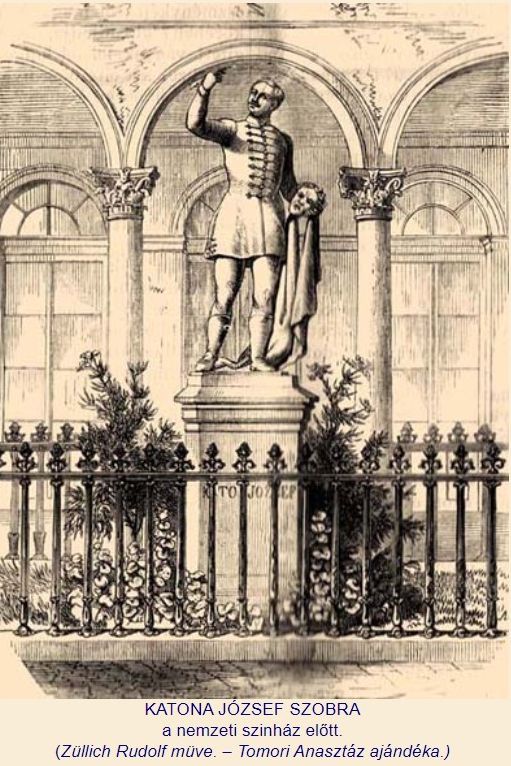
Statue of József Katona in front of the National Theatre. The first public memorial statue in Budapest, created by Rudolf Czélkuti-Züllich (Source: Vasárnapi Ujság, 17 October 1858)
During these years, memorial statues of great thinkers, great writers and poets appeared in public places all over Europe. Thus, of course, the sculpting was continued in Budapest as well.
In the Museum Garden, Dániel Berzsenyi was the first Hungarian poet to be honoured with a public bust, which was inaugurated on 29 May 1860. Its creator was the sculptor Miklós Vay, and his granite foundation was made by Antal Gerenday. Vay handed over his work as early as 1859 and it was temporarily placed in the library of the National Casino as he had to wait for the pedestal to be completed. However, the statue was unexpectedly and, ignoring all the ceremonies, suddenly erected in the garden.
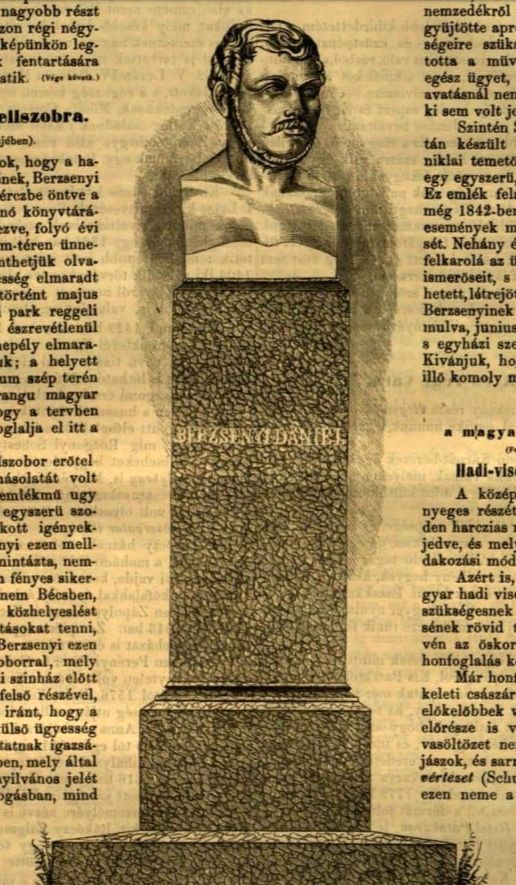
Statue of Dániel Berzsenyi made by Miklós Vay in the 3 June 1860 issue of the Vasárnapi Ujság
 The statue of Dániel Berzsenyi nowadays in the Museum Garden (Photo: Balázs Both/pestbuda.hu)
The statue of Dániel Berzsenyi nowadays in the Museum Garden (Photo: Balázs Both/pestbuda.hu)
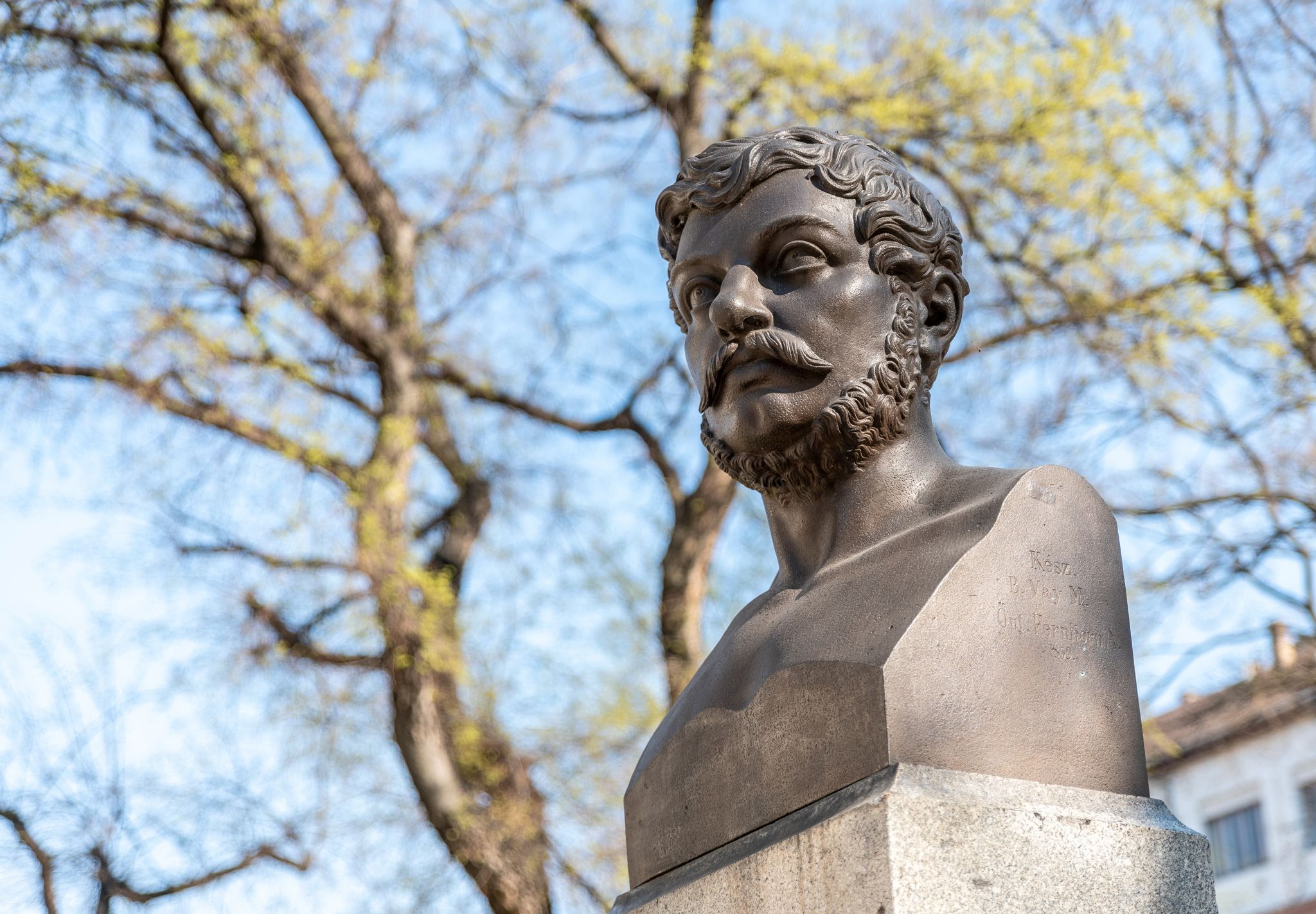
Statue of Dániel Berzsenyi in the Museum Garden (Photo: Balázs Both/pestbuda.hu)
The correspondent of the Vasárnapi Ujság, who called Berzsenyi “the flaming soul poet of the great ode”, expressed his disapproval in the 3 June 1860 issue. He complained that the work had been set up unnoticed, without an inauguration ceremony, in such a way that at dawn on 29 May, the morning walkers of the museum park “looked at the guest transported unnoticed in surprise".
The museum garden work was not left without a companion for a long time. It has been decided before, that five statues will be erected in the garden of the National Museum: sculptures of Kazinczy, Kisfaludy, Berzsenyi and Vörösmarty (the latter was eventually left out) in the four “corners” of the garden, and the statue of Count Ferenc Széchényi, the museum's founder, in the centre.
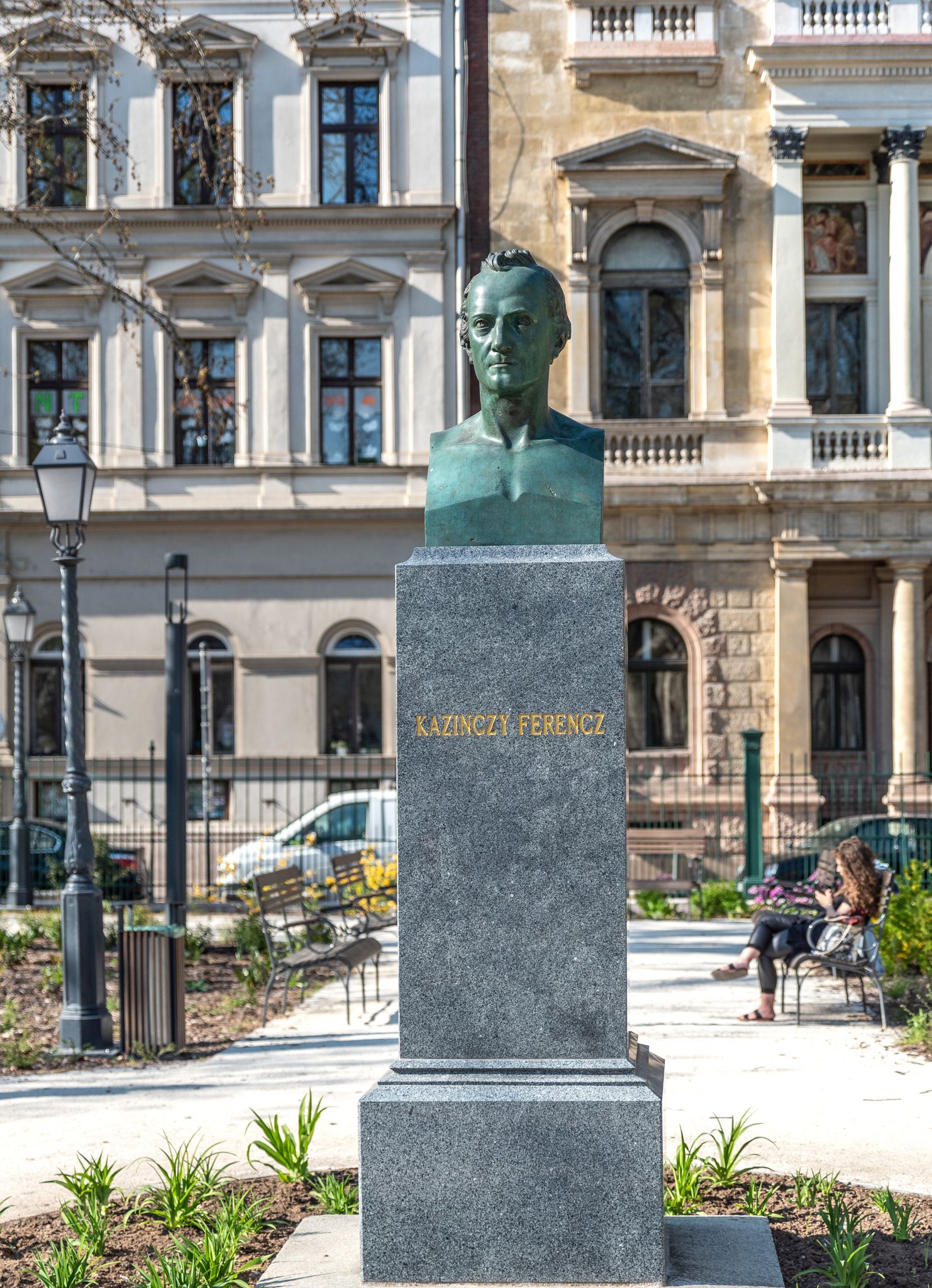
Statue of Ferenc Kazinczy, the work of Miklós Vay nowadays in the Museum Garden (Photo: Balázs Both/pestbuda.hu)
The statue of Ferenc Kazinczy on a granite foundation was also made by Miklós Vay, just like Berzsenyi's, and it was erected on 16 March 1861.
However, the portrait of Károly Kisfaludy was inaugurated only much later, in 1875. Although the artist, István Ferenczy, made his work in 1836 on behalf of the company established in memory of Kisfaludy (later the Kisfaludy Society), as the poet's followers added money from public donations, the erection of the statue took such a long time that the artist died in 1856 without receiving his salary for the work.

Statue of Károly Kisfaludy, the work of István Ferenczy nowadays in the Museum Garden (Photo: Balázs Both/pestbuda.hu)
Kisfaludy's statue laid in the warehouse of the National Museum for a long time, and finally, after a long tug of war, twenty years after its completion, it was erected in the Museum Garden. (However, the work was bombed, destroyed in World War II, and only re-carved in 1952.)
In the meantime, the sculpting of monuments gained more and more space, and there was an increased demand in Budapest to erect statues of the heroes and great figures of the nation. Ten years after the defeat of the revolution, the issue of the statue of Sándor Petőfi, who died in the War of Independence in 1849, could have been raised. The collection began in 1860, at the initiative of violinist Ede Reményi, who returned home from emigration and gave concerts for the benefit of the sculpture fund. The necessary amount was quickly raised from public donations, but the official bodies did not allow the establishment of the sculpture commission until after the Compromise in 1867.
As early as 1871, it was decided to entrust Miklós Izsó with the creation of the monument. In 1873, the Public Works Council designated the site of the statue on the banks of the Danube, opposite the Greek Orthodox church. The body had to decide about an extreme monument: compared to the earlier, more modest portraits of poets, Miklós Izsó imagined a 375 cm tall figure of Petőfi standing on a 535 cm grey granite base (the latter was designed by architect Miklós Ybl), i.e., in the plans the bronze statue appeared as a defining ornament of the Danube Bank. (At that time, the monumental statues in Pest already had antecedents, the Széchenyi Monument, the statue of József Eötvös, was erected, and before that the prestigious statue of Palatine Joseph was also inaugurated).
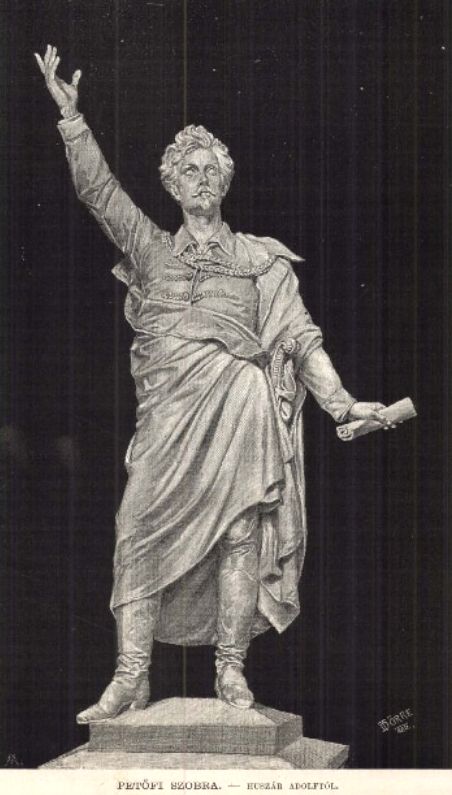
Statue of Sándor Petőfi in the 15 October 1882 issue of the Vasárnapi Ujság. Miklós Izsó was commissioned to make the sculpture, but due to his death, Adolf Huszár finished the work
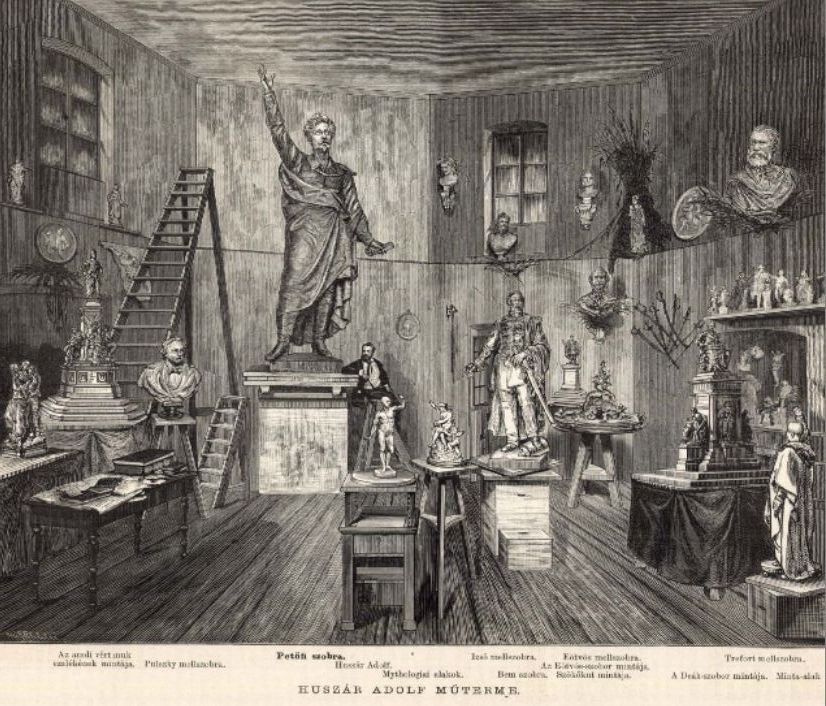
Adolf Huszár's studio, in it the statue of Sándor Petőfi (Source: Vasárnapi Ujság, 15 October 1882)
In the end, the work was not completed by the beginning of 1873, Petőfi's 50th birthday, as the customers wanted, and even Miklós Izsó could not finish his great work, as he died in 1875. The work was taken over by Adolf Huszár, who made the sculpture based on a small sample from Izsó. The work, inaugurated on 15 October 1882, depicts the poet, the orator, who steps forward with his left foot, raises his right arm vigorously, holds a scroll in his left hand while reciting the National Song (Nemzeti Dal - Talpra magyar). That is how the newspaper articles published after the handover called the people's attention.
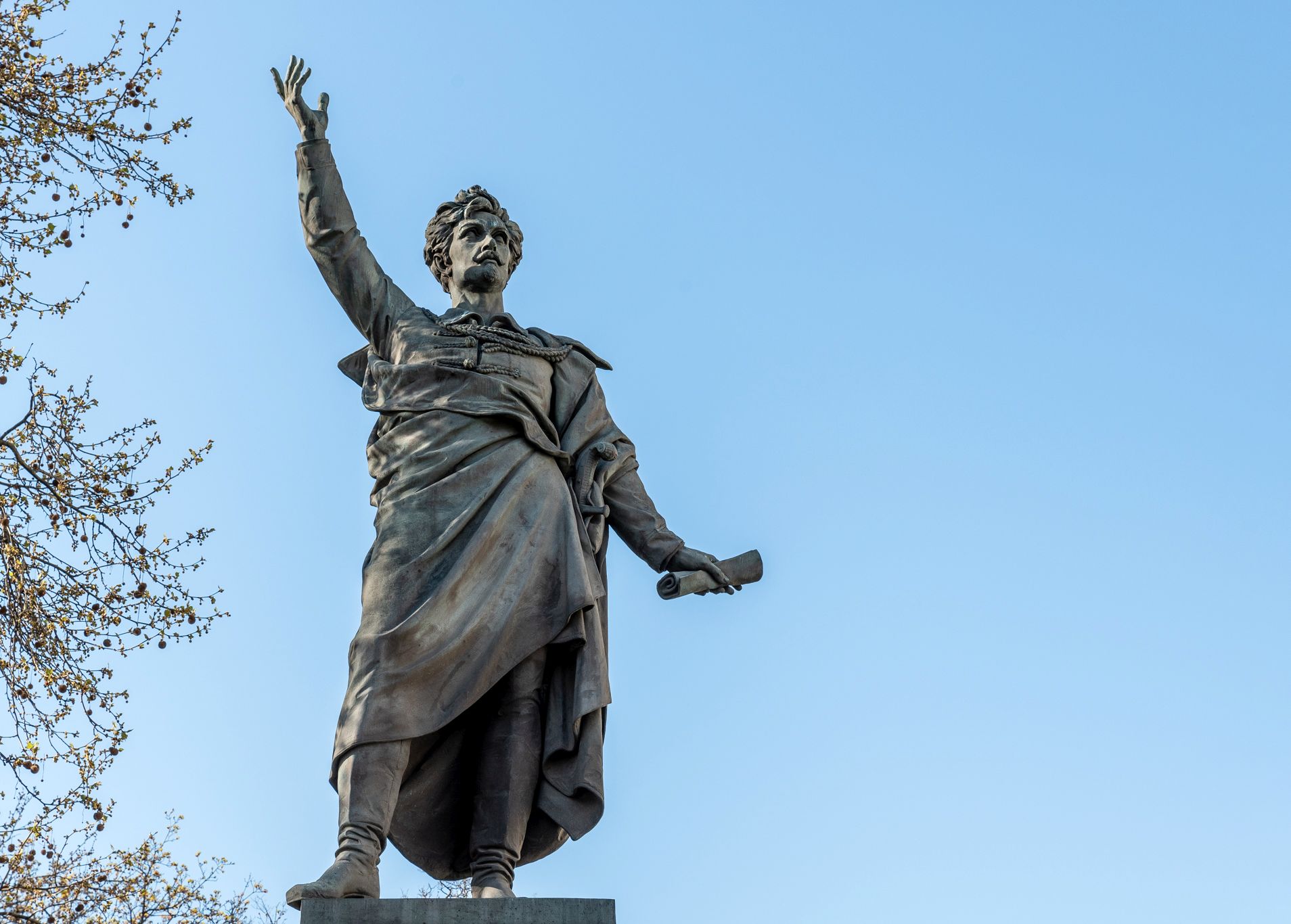 The sculpture of Petőfi by the Danube was inaugurated in 1882, the work was made in the studio of Adolf Huszár based on a small sample of Miklós Izsó (Photo: Balázs Both/pestbuda.hu)
The sculpture of Petőfi by the Danube was inaugurated in 1882, the work was made in the studio of Adolf Huszár based on a small sample of Miklós Izsó (Photo: Balázs Both/pestbuda.hu)

Statue of Sándor Petőfi in the city centre, in the square named after him, nowadays (Photo: Balázs Both/pestbuda.hu)
A monumental work also immortalised the figure of János Arany, the sculptural composition was erected in front of the main stairs of the Hungarian National Museum on 21 May 1893. The huge monument was built from public donations as well. Immediately after the death of Arany, the collection began in 1882, and the sculpture committee was chaired by Ágoston Trefort, Minister of Religion and Public Education, President of the Hungarian Academy of Sciences. The most outstanding sculptors entered the announced competition, of which György Zala and Alajos Strobl were invited to the second round, and the latter won. The entries were also presented in the Industry Hall (Iparcsarnok) of the City Park following the customs of the time.
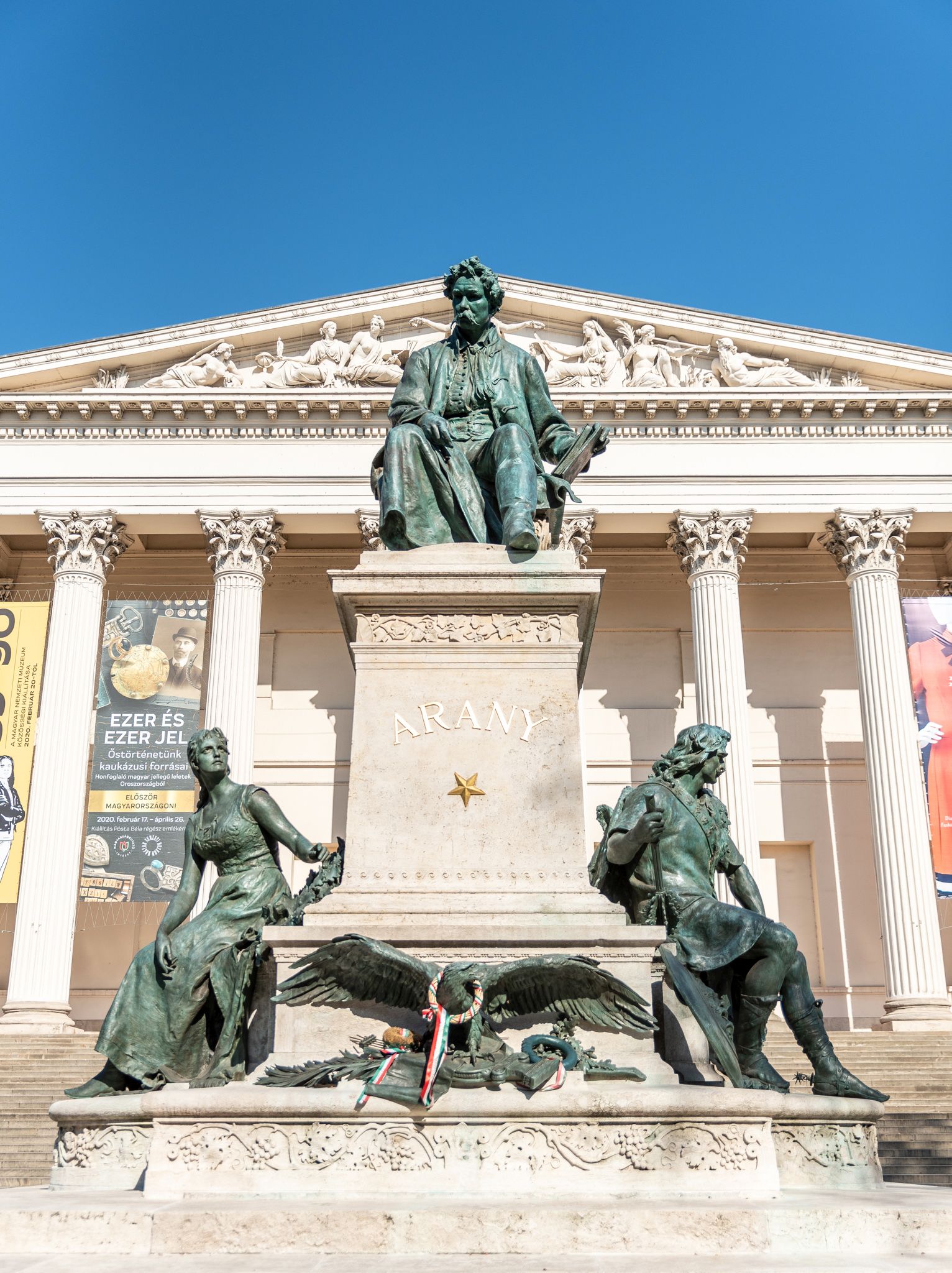 The monument of János Arany, the work of Alajos Strobl in front of the Hungarian National Museum, the side figures depict Miklós Toldi and his love Piroska Rozgonyi (Photo: Balázs Both/pestbuda.hu)
The monument of János Arany, the work of Alajos Strobl in front of the Hungarian National Museum, the side figures depict Miklós Toldi and his love Piroska Rozgonyi (Photo: Balázs Both/pestbuda.hu)

János Arany sits on a stone bench on Alajos Strobl's work (Photo: Balázs Both/pestbuda.hu)
Strobl, who had meanwhile been appointed head of the master school of sculpture, had access to a studio with huge ceilings in the Epreskert, where he was able to make the monumental work (the pedestal of which was made of stone by architect Albert Schickedanz). The sculptor depicted the moment when Arany was sitting on a stone bench under his favourite oak trees on Margit Island in a simple Hungarian dress with a slightly bent posture, on his knees his famous stapled book, into which he used to write his poetic thoughts - explains the author of the Vasárnapi Ujság on 14 May 1893 the artistic concept.
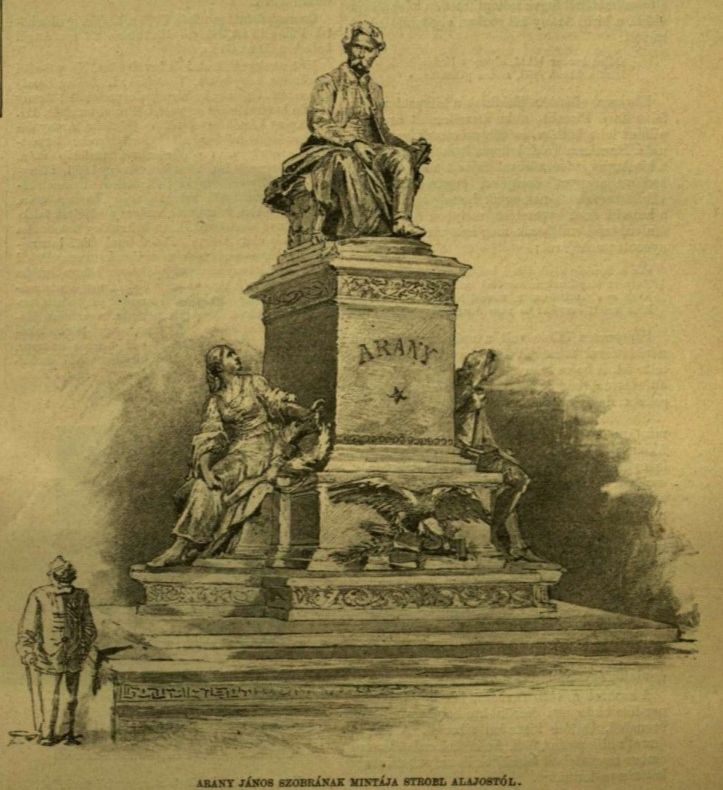
Plan of the statue of János Arany on the drawing of Alajos Strobl (Source: Vasárnapi Ujság, 14 May 1893)

The main figure of the Arany monument in the studio of Alajos Strobl (Source: Vasárnapi Ujság, 14 May 1893)
On both sides of the statue, the characters of the Toldi trilogy can be seen: Miklós Toldi on one side and Piroska Rozgonyi on the other. According to the article writer, Toldi’s huge figure just swells with strength. And Piroska looks up at the poet with a ghostly face and offers him an oak wreath. The author of the article, Dr Dénes Kovács put it this way: it was a lucky idea for the artist to portray the muse of folk poetry in the form of Piroska, who is dressed in Hungarian clothes and her face is a real Hungarian type. He expressed his opinion that the ore statue does not proclaim the greatness of Arany, because it is preached more than any memory by his works, but by the recognition and reverence of the Hungarian nation for the great poet.
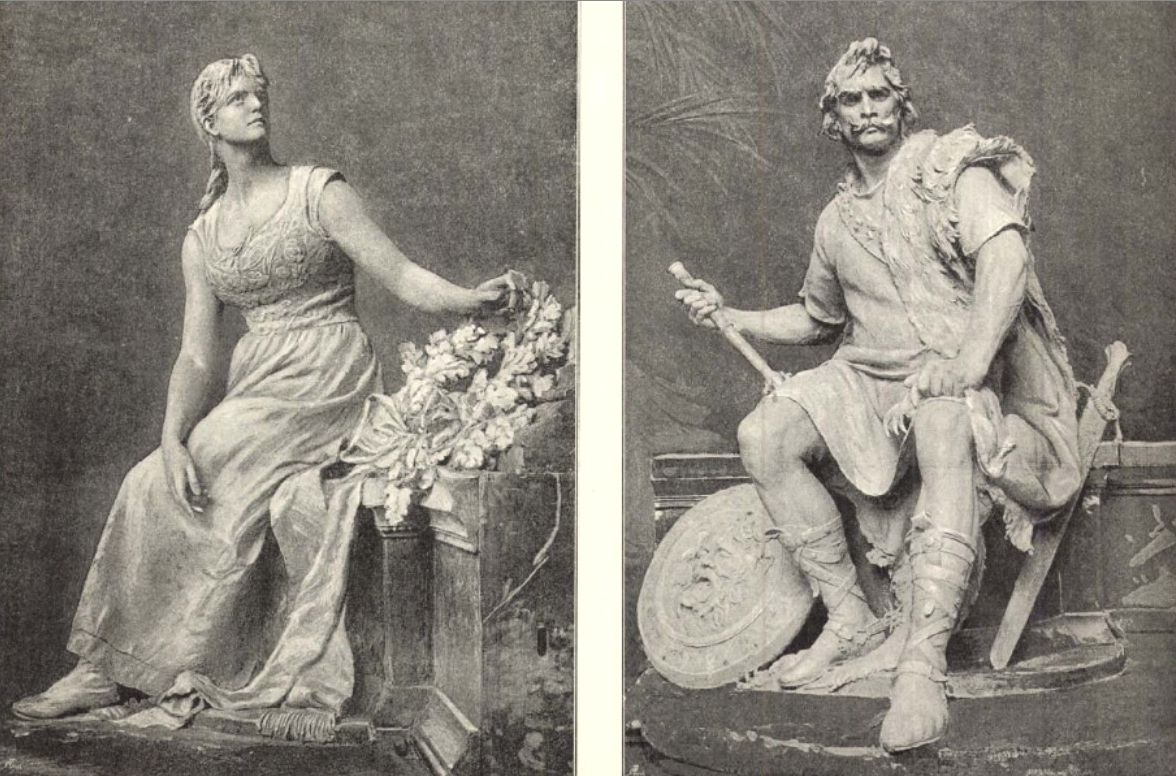
Piroska Rozgonyi and Miklós Toldi, side figures of the János Arany monument (Source: Vasárnapi Ujság, 14 May 1893)
In addition to Petőfi and Arany, we have another poet whose monument was erected in Budapest: Mihály Vörösmarty. By the time his sculpture was completed in 1908, they had amassed vast experience in creating public works of fine art, as a whole series of prestigious works were made throughout the city, especially during the millennium celebrations (as streets, squares, and ornaments on buildings).
The Vörösmarty monument is located on Gizella Square (renamed Vörösmarty Square in 1926). The construction of the sculpture was characterised by the long preparatory work of the age, about forty entries competed, and the plan of Ede Kallós came out victorious. The pedestal made of Haraszti limestone was designed by architect Géza Márkus.
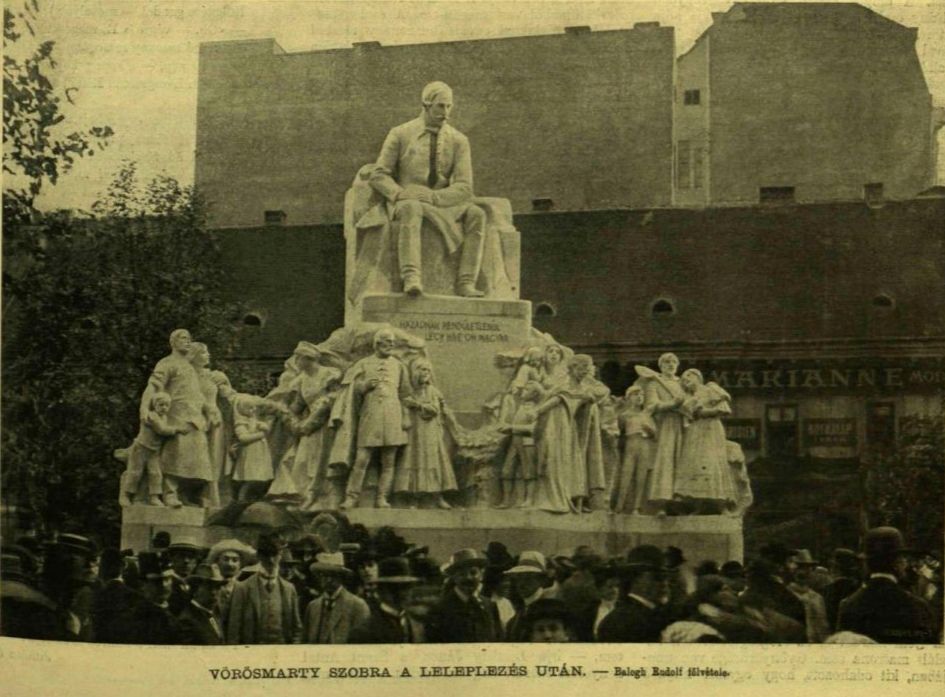
Statue of Mihály Vörösmarty made by Ede Kallós on Gizella Square, on the day of the inauguration (Source: Vasárnapi Ujság, 31 May 1908, photographed by Rudolf Balogh)
In the huge work made of Carrara marble, the poet sits on a bench just like Arany (only on a marble bench), he can be seen with a circle beard, in Hungarian costume like Arany, his figure leans slightly forward, just like that of Arany, and he meditates just like his fellow poet. Under the legs of the main figure, however, on two sides, many secondary figures appear: a multitude of people, men, women, children, young and old. On the pedestal, under the throne, where the crowd splits a little, the poet's message can be read from the Appeal (Szózat): "To your homeland without fail be faithful, O Hungarian!". And there, under the inscription, are the addressees, Hungarians, families, citizens of the nation, representatives of different strata of society, who are loyal to their homeland, and who seem to be fulfilling this wish of the poet. Unlike the motionless figure of Vörösmarty, the side figures are in motion, starting, stepping, or just waiting, but this waiting is also a state just before departure.
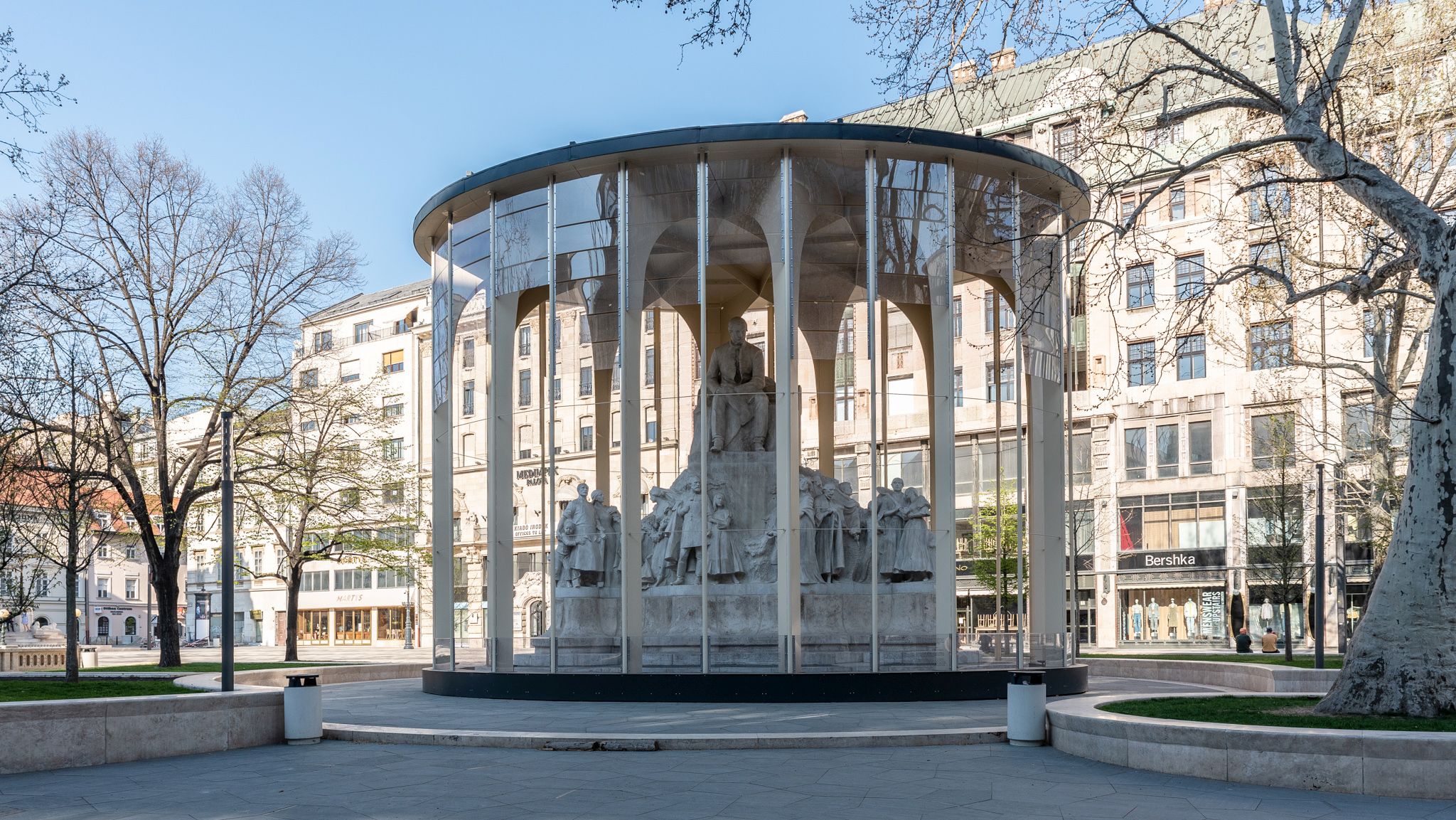
The monument of Mihály Vörösmarty is still surrounded by the winter pavilion erected in November in Vörösmarty Square (Photo: Balázs Both/pestbuda.hu)
In his report on the inauguration of the statue on 31 May 1908, the author of the Sunday Newspaper wrote about the figures of the monument, representing all walks of life, craftsmen, shepherds, field workers, a gentleman, a student, a group of field workers, an old matron, “they are all enthusiastic and collective advocates of national feeling and racial togetherness,” he said. The inauguration took place as part of a huge ceremony, with members of the government and Archduke Joseph also present.
The sculpture of Ferenc Kölcsey, also the work of the sculptor Ede Kallós, is in Batthyány Square in the 1st District, but it was not originally made for here. The original work depicting the poet in a sitting position with an open book in his hand stood in Nagykároly since 1897, but after World War I the statue was destroyed by the Romanians. The copy of the statue was made based on a small plaster sample, and it was inaugurated on the 100th anniversary of Kölcsey's death in 1939 in Batthyány Square, in the middle of it, roughly where the building leading to the metro exit now stands. The statue was placed on a 185-centimetre-high red marble pedestal, on which only that much could be read in capital letters: KÖLCSEY.
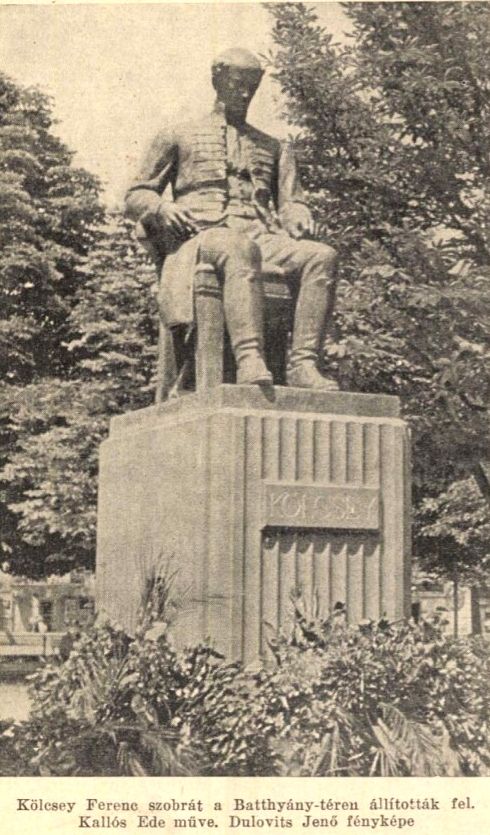
A copy of the statue in Nagykároly of Ferenc Kölcsey was erected in Batthyány Square in 1939. The original work, the work of Ede Kallós, was destroyed by the Romanians who took possession of the city in Szatmár County (Source: Uj Idők, 2 July 1939).
Due to subway construction, the statue was demolished in 1950 and taken away from the site but was brought back in 1974 and placed on the northern edge of the square, on a much lower pedestal than before. Behind it, a wall was erected on which the lines of the poem Huszt can be read. This situation of the work deprived the work of art of its rank and diminished its significance. In its former place, in the middle of the square, on a higher pedestal, the statue of the author of the Hymn was much more accentuated than in its present place, set aside. The poet of Hymn deserved more fair treatment than this, especially since the work depicting him had once been destroyed in Nagykároly. Due to the unfairly low pedestal, the inscription KÖLCSEY is almost on the ground.
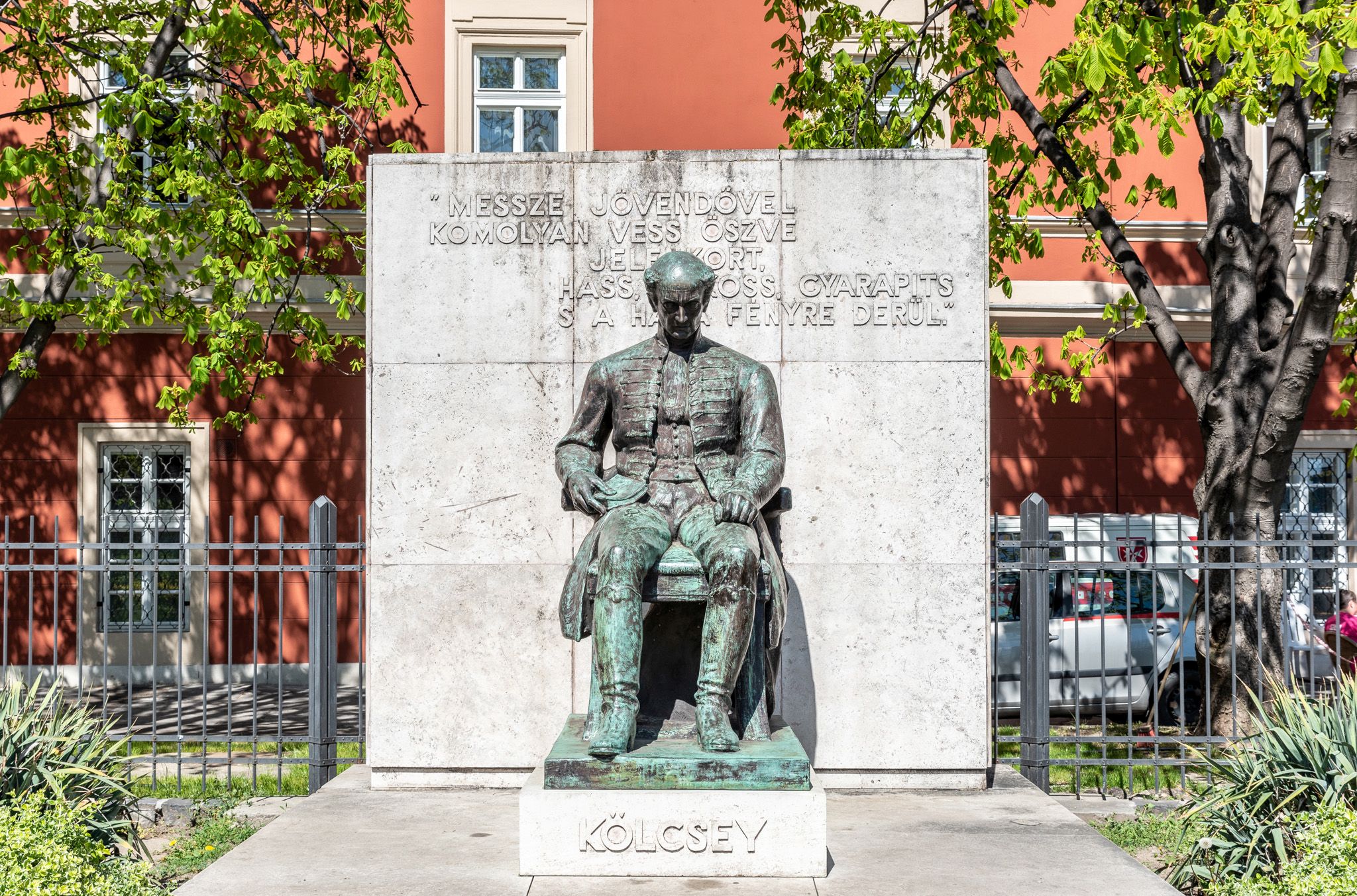
The statue of Ferenc Kölcsey nowadays in Batthyány Square (Photo: Balázs Both/pestbuda.hu)
The big question is whether, if the Romanians do not destroy the work in Nagykároly, would there be a statue of the poet of Hymn in Budapest today. At present, apart from the halls of the schools, a Kölcsey statue stands in only two parts of the city, which were annexed to Budapest in 1950.
Among the great creators of the 19th century, history treated Imre Madách badly as well. Although the result of the Madách monument competition was announced in 1938 and Zsigmond Kisfaludi Strobl was the winner, the work was not completed due to the war. The great creator of The Tragedy of Man has had a public sculpture in Budapest only since 1973, the work of Tibor Vilt, also in a secluded place, near the Promenade of Hungarian Artists on Margit Island.
Among the great Hungarian classics, there is also no statue of Mihály Csokonai Vitéz in the most important public areas of the capital, he only can be seen on the Promenade of Hungarian Artists on Margit Island, if anyone would like to visit his monument on Poetry Day (the bust was made by Dezső Erdey). The public sculpture (also a bust) of the author of the Bánk Ban, József Katona, made by Lajos Petri, can only be seen there as well. Interestingly, the statue of József Katona was taken from Budapest to Debrecen in 1881, but in 1936 the theatre had a bust made about him, which stood in the foyer until the building was demolished 55 years ago. Sári Somló's work was then placed in the garden of the Gizi Bajor Actors' Museum.
The bust of Bálint Balassi can also be found on the Promenade of Hungarian Artists on Margit Island, originally inaugurated in 1969 on the 375th anniversary of the poet's death. The work by István Tar was stolen in 1997, but in 1999 Enikő Szöllősy made a new sculpture in its place. There is also a full-length statue of Balassi in Budapest, which was erected in 1959 on Kodály Körönd, in place of the removed statue of Count János Pálffy. The latter was the work of Károly Senyei, one of the ten sculptures donated by Franz Joseph, while Pál Pátzay was commissioned to shape the famous figure of 16th-century Hungarian poetry.
From the great generation of poets of the first half of the 20th century, statues of Endre Ady, Mihály Babits, Attila József, Dezső Kosztolányi and Miklós Radnóti were also erected in the capital. Several statues of Endre Ady can be visited, the most significant of which is the bronze work of Géza Csorba, inaugurated in 1960, which is in Liszt Ferenc Square, on the site where the statue of architect Ödön Lechner originally stood since the 1930s, but it was taken from there in 1948, claiming that a bus station would be established in the area.
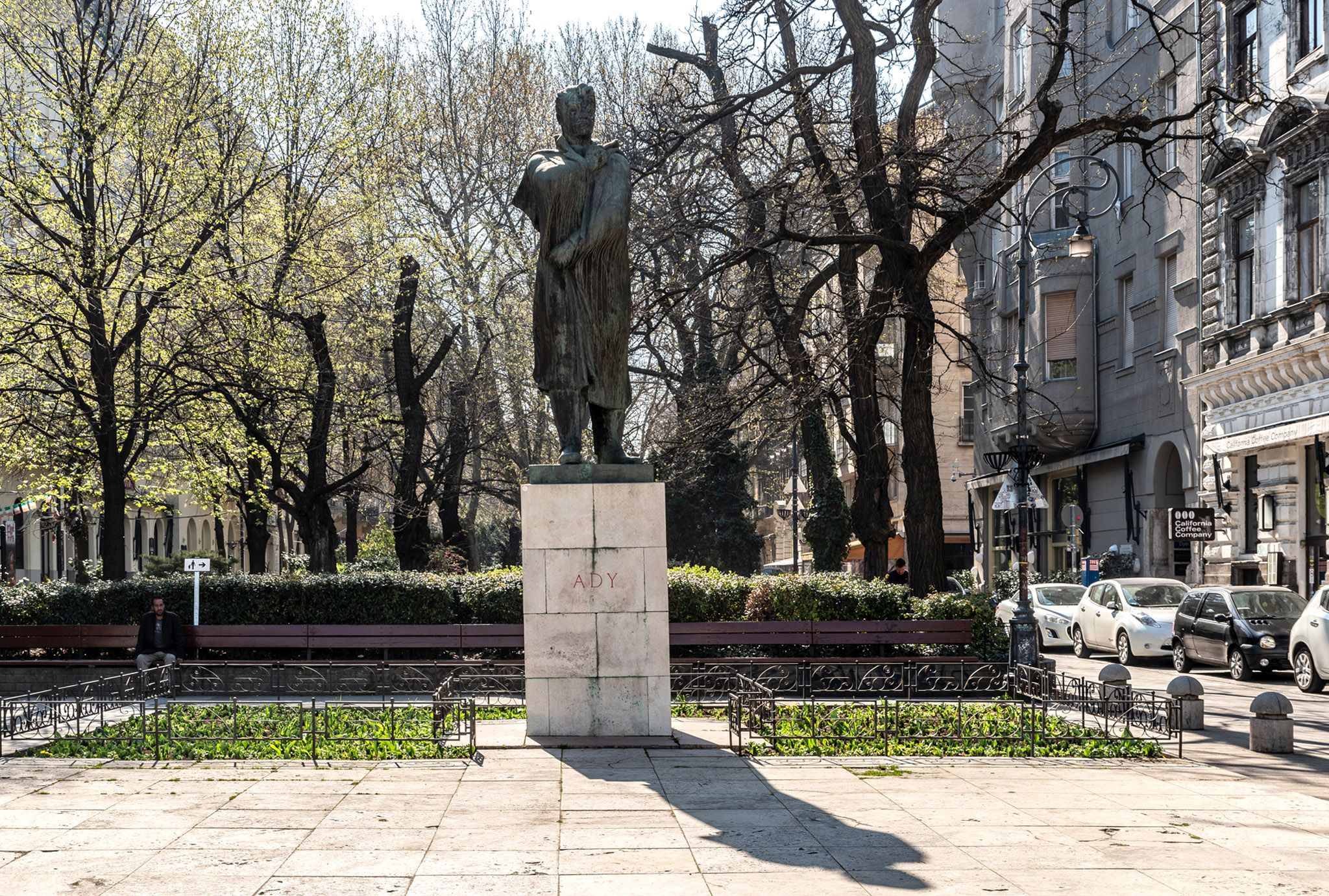
Statue of Endre Ady in Liszt Ferenc Square today, by Géza Csorba (Photo: Balázs Both/pestbuda.hu)
The statue of Dezső Kosztolányi, the work of Tibor Borbás, was inaugurated in 1979 in the square named after him, next to the Bottomless Lake. In fact, it is only a half-statue, the figure of the poet's arm and upper body can be seen. Part of the work is a book in front of Kosztolányi on a much lower pedestal, the volume entitled Magic (Mágia), published in 1912, which contains the poet's poems.
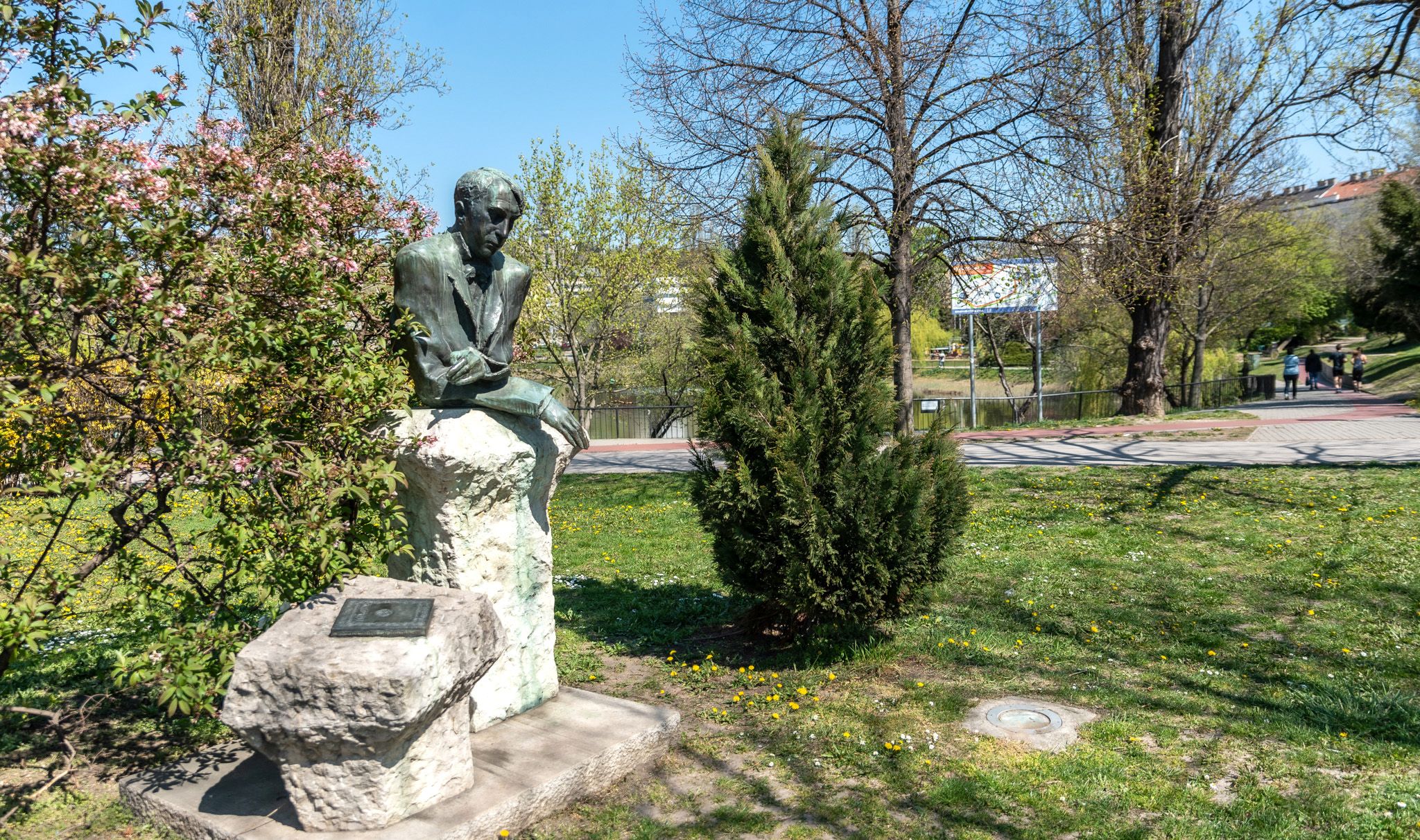
Statue of Dezső Kosztolányi next to the Bottomless Lake (11th District), by Tibor Borbás (Photo: Balázs Both/pestbuda.hu)
The bronze statue of Attila József was inaugurated on 22 December 1980 in Kossuth Square. The title of the sculptor László Marton's work, By the Danube, refers to the poet's poem of the same title, which begins as follows: „ On the bottom step that from the wharf descends / I sat and watched a melon-rind float by”. This is Attila József's most analysed poem. The statue was placed on the south side of the Parliament, where the statue of Gyula Andrássy stood before the war. Since the monument to the Prime Minister of the Compromise was restored to its original location in 2016, the statue of the poet was brought closer to the Danube. After the completion of the depiction of Attila József, several people criticised it, but today it is one of our best-known public poet sculptures.
.jpg) Statue of Attila József on the southern side of the Parliament, on the banks of the Danube, by László Marton (Photo: Balázs Both/pestbuda.hu)
Statue of Attila József on the southern side of the Parliament, on the banks of the Danube, by László Marton (Photo: Balázs Both/pestbuda.hu)
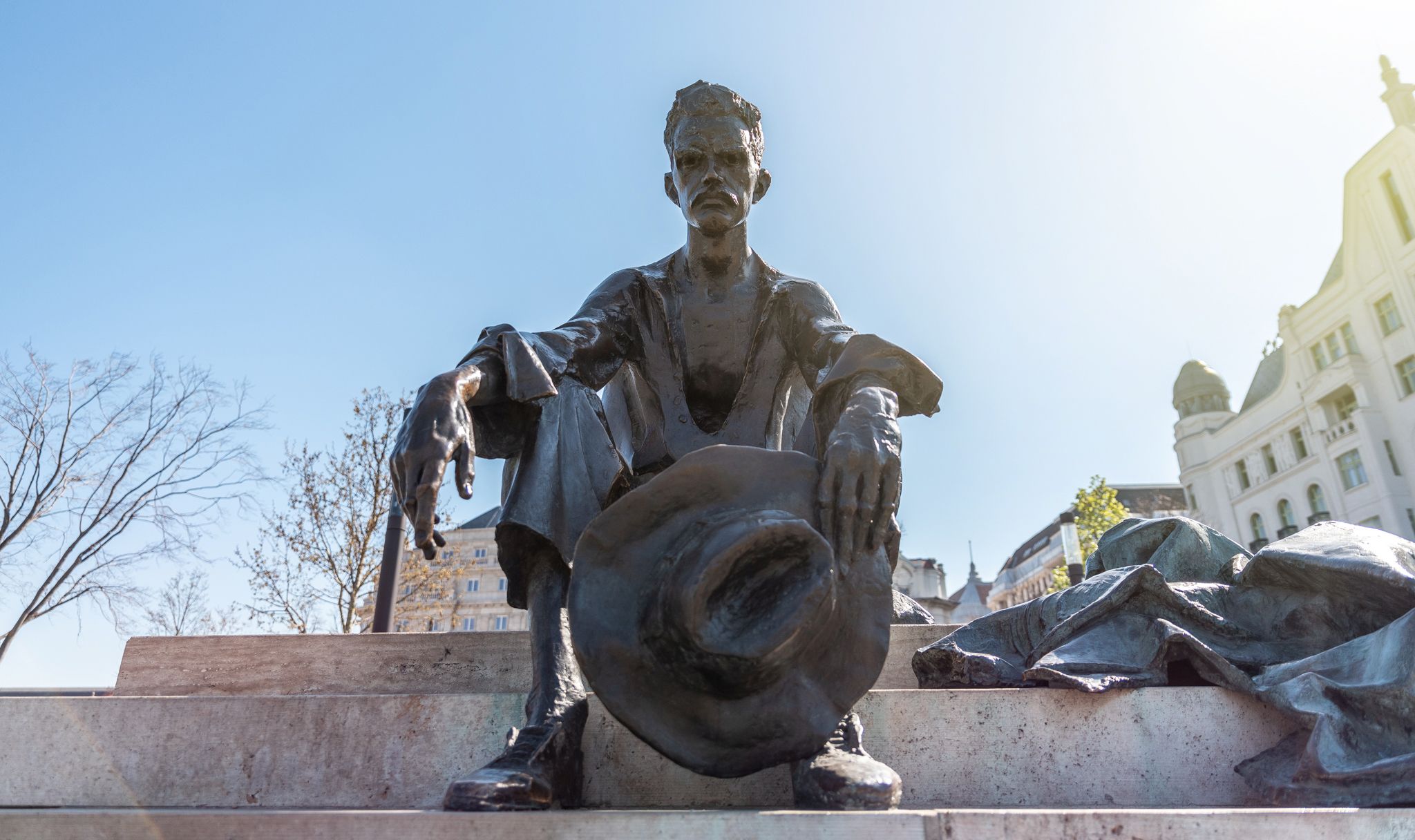
The statue of Attila József was brought closer to the Danube (Photo: Balázs Both/pestbuda.hu)
The bronze statue of Mihály Babits, the work of the sculptor László Marton, was inaugurated on 26 November 2008, the 125th anniversary of his birth, in the 1st District, in Vérmező, near the house on Attila Road where the poet lived. This is Babits' first and still the only public statue in Budapest. Next to the sculpture, there is also a quote wall, designed by architect József Finta, on which quotes from poems can be read by the poet.
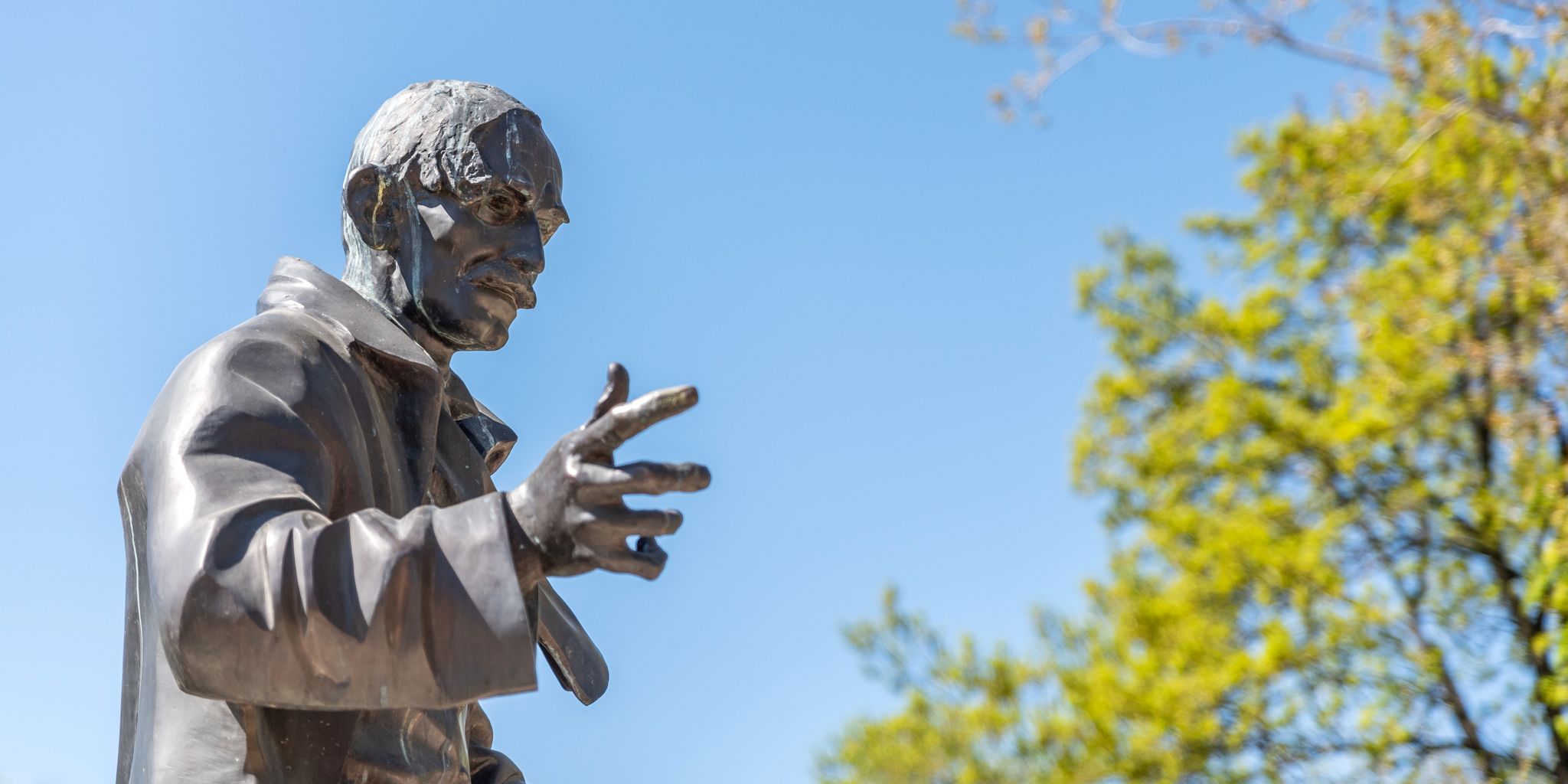
The statue of Mihály Babits, the work of László Marton was erected in Vérmező (Photo: Balázs Both/pestbuda.hu)
Miklós Radnóti's first full-length public sculpture in Budapest, the work of Imre Varga, was inaugurated on the 100th anniversary of the poet's birth in 2009 in the 6th District, in front of 11 Nagymező Street, near the Radnóti Theatre. The bronze statue of the poet, who leans on the railing and delves into his thoughts, is a copy, there are several copies of it. The work of art was inaugurated in Mohács and Salgótarján in 1970, but it can also be found in Bor, Serbia, where Radnóti was in a labour camp. In Budapest, in the 13th District, on the corner of Radnóti Miklós Street and Pozsonyi Road, near the poet's former residence, his now full-length sculpture, the work of Frigyes Janzer, was unveiled in 2015. It is interesting to note that the poet leans on the railing just like in the work of Imre Varga.
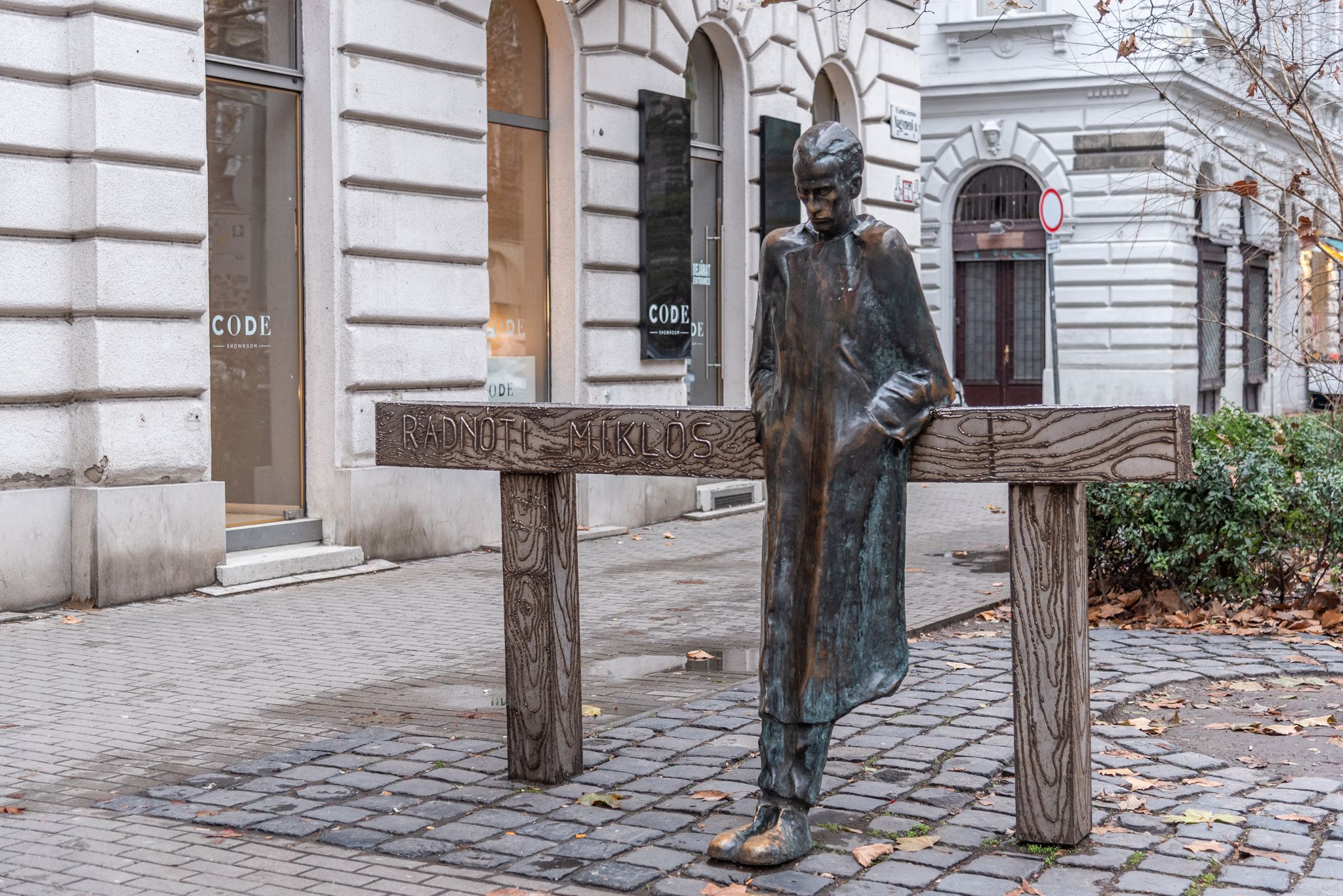
Statue of Miklós Radnóti in the 6th District, in front of 11 Nagymező Street, by Imre Varga (Photo: Balázs Both/pestbuda.hu)
During the walk today, of course, Pestbuda did not get to all the poet sculptures, because there are many more works in Budapest than those listed, but the most important thing could be seen: Budapest appreciates its poets. Compared to the first half of the 19th century, when Gábor Döbrentei established the National Sculpture Association to find people who nurtured the nation's arts, the capital went a huge way: a significant number of our immortal poets were etched into eternal memorials by the greatest sculptors.
Cover photo: Statue of Attila József at the Danube, by László Marton (Photo: Balázs Both/pestbuda.hu)

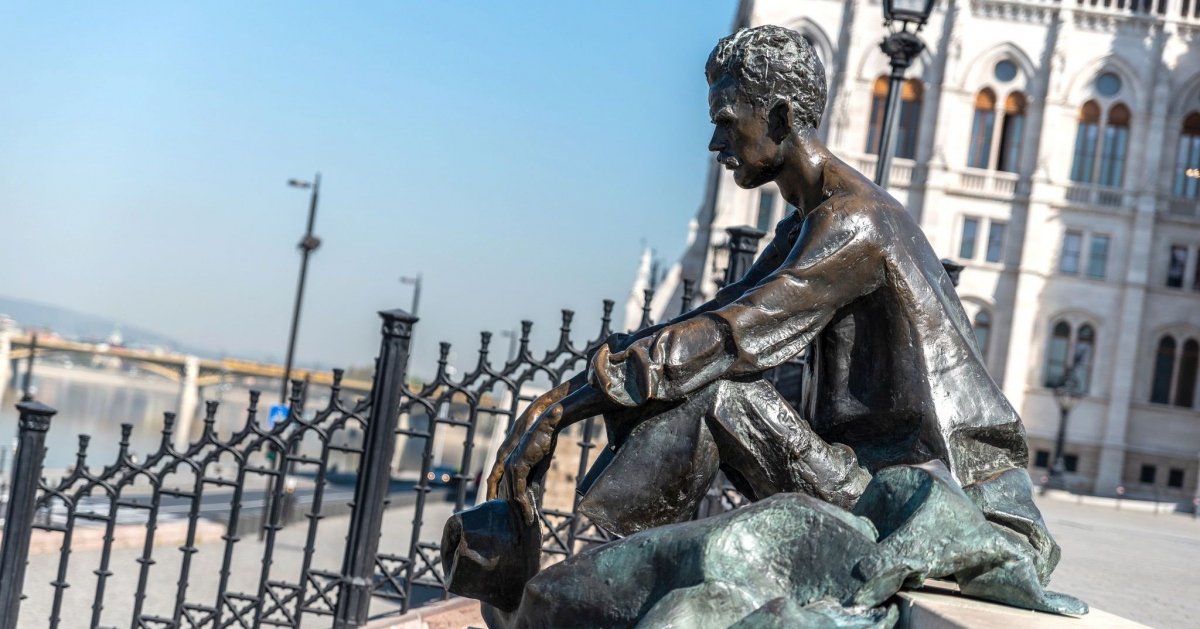





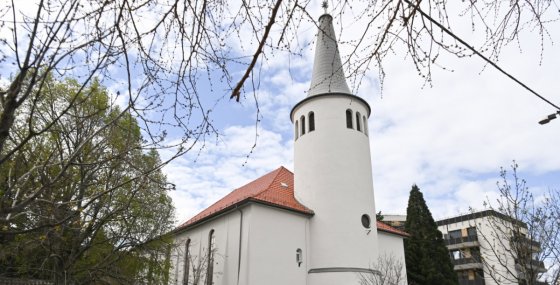




























Hozzászólások
Log in or register to comment!
Login Registration